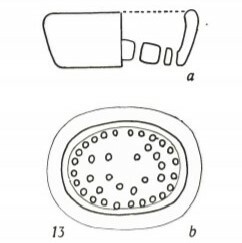Pontosphaera sparsiforata
Set number: 1890
-
1
-
2
-
3
-
4
-
5
-
6
-
7
-
8
-
9
-
10
-
11
-
12
10µm
Set number: 1891
-
1
-
2
-
3
-
4
-
5
-
6
-
7
-
8
-
9
-
10
-
11
-
12
-
13
-
14
-
15
-
16
10µm
Set number: 1892
-
1
-
2
-
3
-
4
-
5
-
6
-
7
-
8
-
9
-
10
-
11
-
12
-
13
-
14
-
15
-
16
-
17
-
18
-
19
-
20
10µm
Set number: 1893
-
1
-
2
-
3
-
4
-
5
-
6
-
7
-
8
-
9
-
10
-
11
-
12
-
13
10µm
Set number: 1179
-
1
-
2
Fig 1. 12.1µm; Fig 2. 13.6µm
Set number: 1895
-
1
-
2
-
3
-
4
-
5
-
6
-
7
-
8
-
9
-
10
-
11
-
12
10µm
Set number: 1894
-
1
-
2
-
3
-
4
-
5
-
6
-
7
-
8
-
9
-
10
-
11
-
12
10µm
Discolithus sparsiforatus Kamptner, 1948
Pontosphaera sparsiforatus (Kamptner, 1948) Varol, 1989a
Large species of Pontosphaera feature a relatively high wall and a proximal plate with a very thin distal cover. As a result, the interference colour of the central area is much weaker than that of the wall when viewed in plan in XPL. The proximal plate is perforated by pores arranged in a single complete concentric cycle, with additional randomly arranged pores possibly located in the centre. Pontosphaera sparsiforata exhibits laevogyre-inclined extinction lines, with a typical extinction angle of approximately 67° on the distal side and displays length-fast (−) elongation.
Pontosphaera sparsiforata can be distinguished from Pontosphaera trena by its larger size, being greater than 10.0 μm.
Kamptner, E. 1948. Coccolithen aus dem Torton des Inneralpinen Wiener Beckens. Anzeiger der Österreichische Akademie der Wissenschaften, Mathematische-Naturwissenschafliche Klasse, Wien. 157: 1-16.
Roth, P. H. 1970. Oligocene calcareous nannoplankton biostratigraphy. Eclogae Geologicae Helvetiae 63: 799-881.
Varol, O. 1989a. Calcareous nannofossil study of the central and western Solomon Islands. In: Vedder, J.G. & Bruns, T.R., (Eds.), Geology and offshore resources of Pacific island arc-Solomon Islands and Bougainville, Papua New Guinea Regions: Houston, Texas, Circum-Pacific Council for Energy and Mineral Resources Earth Sciences Series. 12: 239-268.
